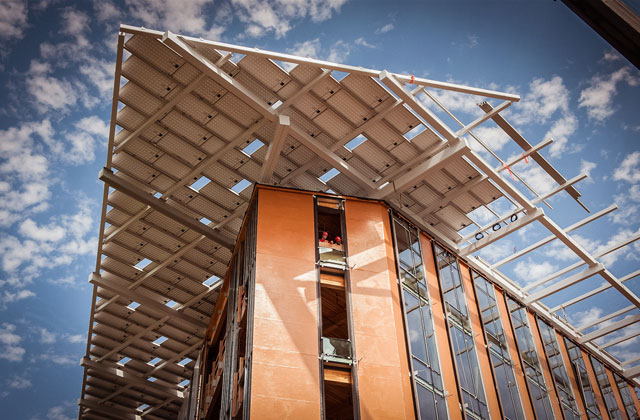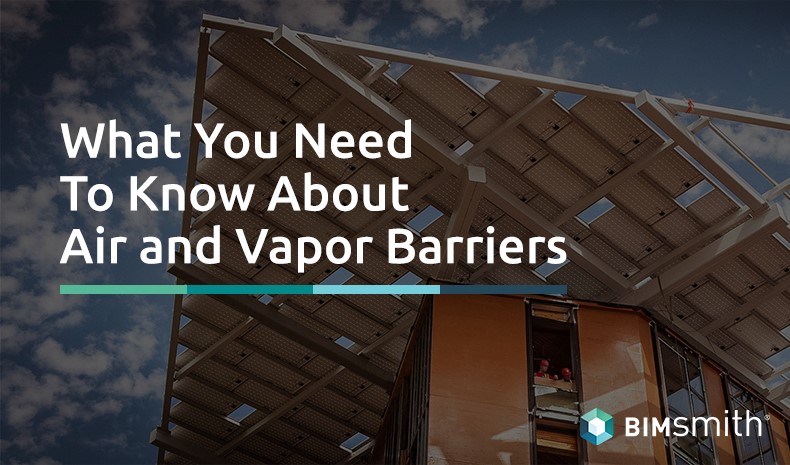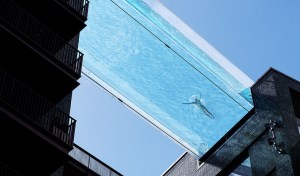Weather barriers, or weather-resistant barriers, are among the most essential components that go into newly constructed buildings and are also becoming increasingly critical in energy retrofit and remodel projects.
High-quality weather barriers are both air- and water-resistant, while still permeable, or ‘breathable,’ to allow for vapor dissipation. The use of a good weather barrier system contributes to a building’s energy-efficiency, as well as occupant health and comfort. An inability to control the intrusion of air and moisture can have serious and even devastating consequences on the structure and lifespan of a building.
That’s why it’s important to get weather barriers right.
But how much do you actually know about air barriers, vapor barriers, and proper usage of each? Though weather barriers play an indisputable role in the sustainability and longevity of a building, they are often misunderstood.
About Weather Barriers
Weather barriers, put simply, are layers in a roof or wall assembly that are designed to keep exterior elements out and keep conditioned air in.
The phrase “weather barrier” most often refers to either air barriers, vapor barriers, or a combination of the two.
Weather barriers, put simply, are layers in a roof or wall assembly that are designed to keep exterior elements out and keep conditioned air in.
Here are some key basics to understanding air barriers and vapor barriers and their role in providing weather resistance.
About Air Barriers
Air barriers are designed to prevent the flow of air between the interior and exterior of buildings. This is especially important in the age of air conditioning, where it is essential for energy efficiency to keep conditioned air inside a building’s walls and unconditioned air outside of them.
An air barrier serves as the shield between the interior and exterior of the building. While other layers in the building enclosure may have varying degrees of permeability, the air barrier should be impermeable to the passage of air.
An air barrier can take many forms, including mechanically fastened building wraps, adhesive membranes, fluid-applied materials, rigid insulation or concrete. Standard sheathing materials like gypsum or plywood partially function as air barriers, but have vulnerability at the seams between individual boards, making their role as an air barrier incomplete.
A wall assembly can contain multiple air barriers, but to stop air intrusion and air leakage, one single, continuous layer with no seams or gaps is critical. For that reason, fluid-applied air barrier membranes are typically the best choice, as they can be applied over rough surfaces, openings, penetrations and they dry as a single, monolithic layer.
About Vapor Barriers
Vapor barriers are intended to control and slow the rate at which moisture can flow through building materials.
The word control is important because complete impermeability is not necessarily helpful. Since at least some degree of moisture will inevitably find its way into a building, it’s important to have a structure that can “breathe,” allowing for moisture to dissipate on its own.
This is why vapor barriers are never placed on both interior and exterior sides of an assembly. This can end up trapping moisture inside the building enclosure and causing more harm than good.
Depending on the climate, a vapor barrier ought to be placed on different sides of an assembly. In cooler climates where the building is heated more often, the vapor barrier should be installed on the interior side of a wall or roof to prevent moisture from entering the assembly from the inside. In warmer, more humid climates, the barrier should be installed on the exterior side of the assembly to prevent exterior moisture from entering the assembly from the outside.
The impermeability of a vapor barrier is often measured in perms (1.0 US perm = 1.0 grain of water vapor/square foot/hour/inch of mercury), where anything lower than 1 perm is viewed as impermeable.
Why are Weather Barriers Important?
It may seem logical to want to prevent air or moisture from entering and exiting a building, but what makes this protection essential?
Weather Barriers are Essential for Durability
Weather barriers provide the most important line of defense protecting the building interior from the elements on its exterior.
Water (whether vapor, rain, or drainage) and air are driven to seams and leakage points by wind, gravity, and natural properties of surface adhesion.
Improper installation or an absence of weather barriers allows for the elements to enter a wall or roof assembly and cause the materials within to deteriorate.
When moisture gets into the building envelope, wooden materials rot, steel materials corrode, and mold begins to grow. Whether from the structural or health hazards, a brand new building can become inhabitable exceptionally quickly without proper weather protection.
Weather Barriers are Essential for Energy Efficiency
The other side of weather barriers is their pivotal role in achieving energy efficiency for a building.
Maintaining any interior environment that is different than the exterior environment presents costs, both financially and environmentally. From air conditioning to climate control to humidity management, it takes energy to maintain a comfortable interior atmosphere. Plus, when comfort is considered on a large commercial scale, the margin to be lost by inefficiency grows substantially.
An improperly installed weather barrier (or ineffective weather barrier product) can leave a building with constant leakage of cost and energy. Just like it’s impossible to keep much water in a cup with holes in the bottom, it’s impossible (or at least cost prohibitive) to maintain a comfortable, efficient building with “holes” throughout its exterior wall and roof assemblies.
Therefore, weather barriers are considered to be key components to the design and construction of green buildings. The Bullitt Center in Seattle, Washington was considered the greenest building in the world at its construction, and part of that recognition was their use of a top-of-the-line fluid-applied weather barrier.

Bullitt Center, Seattle, WA. Photo: Prosoco Product: Cat5 Air and Vapor Barriers (Download)
Construction's Unsung Hero
Proper control of air and vapor leakage is essential to the design of energy-efficient, long-lasting buildings.
As the silent performers nestled into the middle of a wall or roof assembly, the pivotal role of weather barriers in construction is underrated. But as the industry focuses on building longer-lasting, higher-quality buildings in the coming years, weather barriers will be a major part of the discussion.















